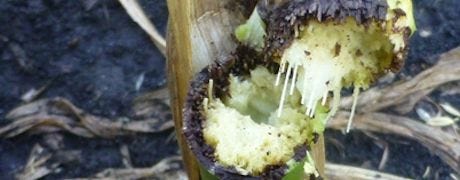October 2, 2013

Two unusual diseases, one in corn and one in soybeans, have been diagnosed by Iowa State University Extension plant pathologists in the past two weeks in Iowa. Extension plant pathologist Alison Robertson has recently written in the ISU Integrated Crop Management newsletter about cornstalk breakage caused by Physoderma maydis, a disease which she explains later in this article (see below). And her colleague, ISU Extension plant pathologist Daren Mueller, wrote an ICM news article last week about Tobacco Streak Virus causing necrotic spots on soybeans (see below).

CORNSTALK BREAKAGE: An unusual disease has been reported in several fields in southwest and western Iowa over the past couple of weeks. ISU Extension plant pathologist says the first symptoms noticed are corn plants that break at the first or second node. The nodes at which breakage occurs are black and some stalk rot of the pith may be present. This has been confirmed as Physoderma maydis.
"I have heard of several reports across Iowa of cornstalk breakage due to Physoderma maydis," says Robertson. "We don't really understand what the circumstances were that led to purple lesions girdling the lower nodes of corn plants rather than the typical brown leaf spot symptoms we usually see. There does not seem to be any correlation with planting date or hybrid."
Regarding Tobacco Streak Virus causing necrotic spots on soybean plants, Robertson says, "Most of the reports and samples we've seen in the ISU Plant Disease and Insect Clinic have been from central and northwest Iowa, but we think this disease may be more widespread. TSV is transmitted by thrips. This insect also vectors soybean vein necrosis virus that was recently reported in Iowa."
Now is the time to start scouting your cornfields for ear rots
"Although many parts of Iowa have experienced drought conditions this year, we do not think there is a risk of aflatoxin in grain since most of the growing season was predominantly cool," says Robertson. "We may be at risk for fumonisins (associated with Fusarium ear rot) or DON/vomitoxin (Gibberrella ear rot), however. In our field scouting we haven't seen a whole lot of ear rot. I'd be interested to hear from farmers about what they are finding in their fields."
Tobacco Streak Virus confirmed on soybean plants in some Iowa fields
Tobacco streak virus is being confirmed in Iowa fields, says ISU plant pathologist Daren Mueller. He suggests farmers and crop consultants learn how to identify the symptoms and where to send the plants for diagnosis. Over the past several weeks, ISU specialists have received several samples in the Plant and Insect Diagnostic Clinic at Ames with irregular blotches and necrotic lesions on the pods.~~~PAGE_BREAK_HERE~~~
After eliminating all of the known causes, a sample was screened for several common bean viruses. The sample came back strongly positive for tobacco streak virus, or TSV.
This virus was first identified in Iowa and the United States in 1967. The soybean plants with "pods showing necrotic spots" were noticed in late-planted soybeans. From this earlier report, TSV reduced the number of pods per plant and delayed seed maturation. Other symptoms include stunting, bud blight, leaf mosaic (mottling), dwarfed leaves and stem discoloration. This virus is mainly seed transmitted and several thrips species have been reported as TSV vectors. If you have soybean pods with similar symptoms, you can send them to the ISU Plant and Insect Diagnostic Clinic. Confirmation of TSV costs $50.

Tobacco streak virus symptoms on soybean pods.
Cornstalk breakage and stalk rot caused by Physoderma in some southwest Iowa fields
An unusual disease has been reported in several fields in southwest and western Iowa over the past couple of weeks. Several samples were received in the Plant Disease and Insect Clinic and pathologists from ISU Extension visited a field in Adair County. Alison Robertson provides the following explanation and information.
Symptoms and signs of this disease -- Physoderma. First symptoms noticed are corn plants that break at the first or second node (Figure 1). The nodes at which breakage occurs are black (Figure 2) and some stalk rot of the pith may be present (Figure 3). Microscopic examination of the symptomatic tissue reveals thousands of light brown sporangia (Figure 4 and 5). This has been confirmed as Physoderma maydis. This fungus also causes the more familiar Physoderma brown spot (Figure 6); however, the foliar symptoms have not been widely prevalent in fields with the stalk rot.
There are a couple of reports of stalk breakage and rot caused by Physoderma. In Illinois, severe outbreaks with up to 80% lodging in some fields were reported in the early 1970s. There were also reports from North Carolina and Mississippi years ago.
Physoderma is not usually an economic problem in Iowa or the United States. In recent years, ISU Extension plant pathologists have seen an increase in the occurrence of Physoderma brown spot on leaves. This may be related to hybrid genetics or the wet springs Iowa has had. The spores can overwinter in soil and infected tissues. Under wet weather conditions, this pathogen produces swimming zoospores and, consequently, free water is necessary for infection to occur. The risk of infection increases at moderate temperatures (73 to 86 degrees F) and when rainwater sits in the whorl for a period of time. Moreover, young corn plants are more susceptible to disease but become more resistant with age.
In order to reduce the risk of infection, choose resistant hybrids and avoid planting susceptible hybrids in poorly-drained areas. Crop rotation and tillage practices may reduce sources of inoculum from soil and infected plant debris.~~~PAGE_BREAK_HERE~~~

Figure 1. Stalk breakage caused by Physoderma maydis in the field

Figure 2. Dark lesions girdling the lower nodes of affected plants

Figure 3. Stalk rot associated with infection by Physodermis maydis

Figure 4. Light brown sporangia of Physodermis maydis in infected stalk tissue

Figure 5. Microscopic view of sporangia of Physodermis maydis

Figure 6. Typical leaf symptoms of Physoderma brown spot
You May Also Like




